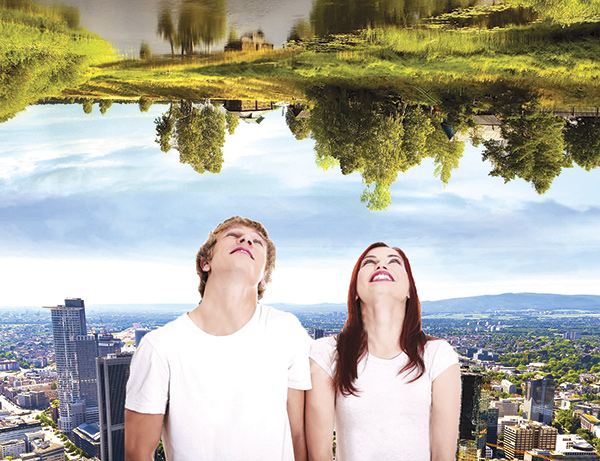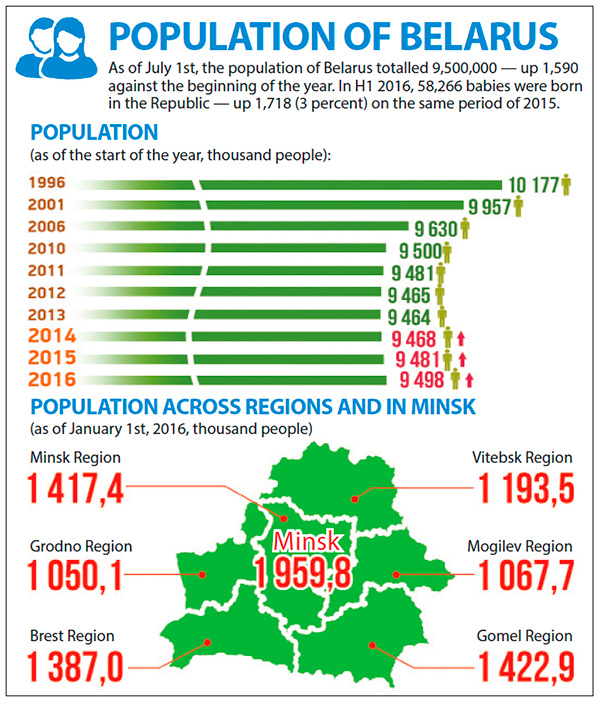
Some cities are growing faster, and others slower, but urbanisation is an unstoppable force. The National Statistical Committee of the Republic of Belarus notes that internal migration from villages to cities has been a long-term trend. Its Department of Demographic Statistics counted 7,325,000 urbanites and 2,156,000 villagers in 2015: 77 percent and 23 percent of the population respectively. In comparison with the previous year, the number of villagers fell by 37,500, while urban living gained 50,000 residents.
Naturally, towns offer more facilities: schools, polyclinics and shopping centres. However, rapid urbanisation also generates problems, placing a strain on services. Natalia Porechina, with water-resources management at the Centre for Ecological Solutions, tells us, “The larger the city, the greater volume of natural resources it consumes; 60 to 80 percent of all world energy is consumed by cities, which are centres for manufacturing as well as residence. This brings increased concentration of water and air pollution, affecting public health, so we need to pay attention to ecological environmental effects.”
She believes that those living in districts with high transport-industrial pressure and few buffer zones between industrial and housing areas are most ‘at risk’. Ms. Porechina recommends considering proximity to industry and busy roads when buying an apartment, advising that suburbs tend to be cleaner than the centre of the city. Of course, commuting to your place of work is tiresome. The rhythm of life can be maddening, with busy traffic, crowds of faces, advertising and high noise levels.
To feel more ‘at one’ with nature and preserve your health, it’s good to travel out of the city each summer. Annually, there has been a trend for the purchase of rural ‘get-a-ways’, although fewer this year. The National Cadastral Agency states that very few new houses purchases were made in the Minsk Region of late, with buyers tending to choose unfinished projects or those needing renovation (up by 37 percent). In May, demand for such properties exceeded that of newly constructed homes almost 20-fold. Experts believe that falling prices for building materials and services may be at the heart of the trend; also, people have realised that it’s cheaper to work on an unfinished or shabby house than to buy something new.
The greatest number of purchases in May was in this segment. In the village of Valerianovo, near Borovlyany, a two-storey unfinished building with a footprint of 368sq.m recently sold for Br4.6 billion. Meanwhile, a 173.5sq.m new home, with land of 8,500 square metres, was purchased for Br3.5 billion in the village Gaishche, near Khatezhino. Experts believe that prices will gain more equilibrium when building material prices return to their former level.

While some people are keen to remain in cities, others are moving to rural homes, down-sizing and leaving the ‘rat race’, reducing their pace of life. Photographer Alexey Piskun is one such, having moved to a village, from Minsk, at the age of 30. He tells us, “Friends say that life begins in Minsk. For me, it began in the village.” Alexey’s girlfriend, Yulia Bondar, was easy to persuade to fall in with the plan. They looked at various unsuitable houses in several villages before spotting one in Losk, in the Volozhin District, which caught their eye. In fact, it was only when they made enquiries that they found its owners were amicable to the idea of selling, and it became theirs.
Yulia and Alexey have made their home comfortable and are planning an agro-estate. They assert that there’s always lots to do, but are superstitious regarding giving too much away. There are always employment opportunities in cities, but there’s no need to be idle in the countryside. Alexey notes, “We’re fond of ethnography, so we want to give our estate Belarusian motifs and themes. We expect to have our first visitors in a month’s time.”
Yulia, having taught singing in Minsk, plans to offer lessons in her new rural home. As the village is just 85km from Minsk, she’s sure that Minsk residents will readily take trips to Losk. The new ‘Volozhin Gostinets’ cycle route is soon to run by, so cyclists will, no doubt, stop to sleep, enjoy a meal, or repair their bicycle. Yulia and Alexey are looking forward to welcoming people.
Many others are following the same path as the young couple, seeking fresh air and a return to nature. Rural living isn’t as basic as it once was of course. Vitebsk resident Raisa Knurova is renting a house in a pretty village for the summer. She tells us, “It takes me an additional hour to travel to work, but I can eat my own greens from the garden. My vegetables are always fresh and are organically grown. I’m getting to know my neighbours and, unless I have a change of heart, plan to move here permanently.”
House prices are modest. In the Vitebsk Region’s Detkovtsy village, in the Braslav District, a single-storey wooden house of 45 square metres, with a plot of 2,500 square metres, costs $7,000. It’s hard work to grow your own vegetables, but very rewarding, as psychologist Anzhelika Stankevich underlines. She advises, “Consider everything: if you make a decision in the heat of the moment, or from curiosity, you may quickly regret it. Townspeople used to noise and attention may feel melancholy and lonely at first, so shouldn’t choose the most remote villages. Rather, select one where relatives or friends live, for support. Decide in advance how you’ll earn your living. Farming and creativity requiring solitude can be strong motivations for rural living.”
By Irina Gorbatenko












